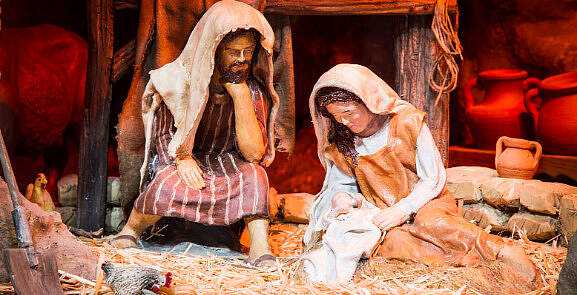
In the 5th century, an apparition of the Child Jesus in the grotto of Bethlehem, held by the Blessed Virgin Mary, with Saint Joseph at her side, took place on Christmas Eve in the village of Ferrières-en-Gâtinais (central France), when three monks, Altin, Savinien and Potentien, were evangelizing near Orléans.
Enthused by this miraculous apparition confirming their preaching, one of them, Savinien, exclaimed: "This place is like a new Bethlehem!" The apparition was recorded in a charter of Clovis (465-511), and in a book written by Loup, Abbot of Ferrières, in 850. Pope Gregory XV also confirmed it in a bull dated 1622.
The chapel dedicated to Our Lady quickly became a pilgrimage site renowned for its many conversions. Tragically destroyed by Attila’s Huns, the church was rebuilt by the future King Clovis before his conversion and baptism. Much loved by Queen Clotilde, Clovis’ wife, the church of Our Lady of Bethlehem was subsequently rebuilt and enlarged during the Merovingian dynasty. Its importance was such that two Carolingian kings, Louis III and Carloman, were crowned there. A second church, dedicated to the apostles Peter and Paul and elevated to a basilica, was consecrated in 1163 by Pope Alexander III.
The abbey adjoining the churches of Our Lady and of St Peter and St Paul became itself an important intellectual center. The whole complex was burned by the English during the Hundred Years' War (1337-1453) and had just finished being rebuilt when the Huguenots in turn brought their own destructions. Having survived so many barbaric attacks, the abbey was finally demolished after the French Revolution, between 1810 and 1830, after being sold as "national property." Fortunately, the two churches have survived: St Peter and St Paul is now a parish church and Our Lady of Bethlehem is also preserved and known as one of the few "respite sanctuaries"(1) existing in France. Attached to it is a cemetery for stillborn children. Pilgrimages are held there every year, especially on September 8th, feast day of the Nativity of Mary.
(1) A respite sanctuary is a Catholic church where, according to tradition, God granted the grace for stillborn babies to come back to life for a few minutes, just long enough to receive baptism, before definitive death.
Adapted from: France